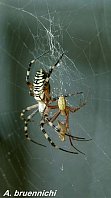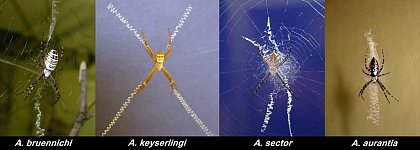Stabilimenta
The adaptive value of web decorations in Argiope spiders

The Araneid spider-genus Argiope is cosmopolitan with currently 76 known species. These orb web spiders are interesting to arachnologists for several reasons. They are characterized by a sexual size dimorphism and sexual cannibalism. So one study focus lies on the question why the larger female preys upon the small male during or shortly after the mating. Secondly, Argiope spiders show a conspicuous web decorating behaviour. They add silken extra structures to their orb webs. But why do spiders that have to rely on the inconspicuousness of their traps add highly visible silk structures? There has to be an adaptive value and thus the function of web decorations is also a major subject of the arachnological research.
Web decorations
Several species within the families Araneidae, Nephiliidae, Uloboridae and Tetragnathidae attach conspicuous silk structures to orb-webs (Herberstein et al. 2000; Bruce 2006). Web decorations are sometimes also called ‘stabilimentum’ (based on Simon 1895) and consists of densely woven zig-zag ribbons. The adaptive value of web decorations is still unclear and controversially discussed. Several functional hypotheses have been proposed, but they tend to be contradictory (Herberstein et al. 2000; Starks 2002; Eberhard 2003; Bruce 2006).
At first it was argued that these structures might have a stabilizing effect to orb webs (Simon 1895), but recent authors consider the adaptive significance of web decorations in another context. The suit of explanations shows a broad range and includes potential functions like prey attraction (Craig & Bernard 1990; Tso 1998; Herberstein 2000; Bruce et al. 2001), camouflage (Schoener & Spiller 1992; Blackledge & Wenzel 2001; Eberhard 2003), moulting platform (Robinson & Robinson 1978; Nentwig & Heimer 1987), thermoregulation (Humphreys 1992) or warning signal for potential web destroyer (Horton 1980; Eisner & Nowicki 1983). Furthermore, web decorations are also claimed to be multifunctional (Starks 2002). Only few authors argue that Argiope’s conspicuous web attachments may have no adaptive significance in orb webs. At least, the fact that the basic patterns of web decorations are highly variable in form (e.g. cruciate, discoid or linear arrangements of the zig-zag bands) and often lack in the webs on both inter- and intraspecific level (Lubin 1975; Eberhard 2003) suggests a little specialized functionality and renders an evolutionary explanation difficult (see Nentwig & Heimer 1987; Nentwig & Rogg 1988; Peters 1993). Thus, for further investigations on ultimate (adaptive) effects of web decorations comparisons between different Argiope-species are necessary.

Apart from ultimate values web decorations may have in the orb web one question remain: Where does the silk that spiders spend for decorations come from? Peters (1993) suggested a physiological coherency between silk gland activity and decorating activity. The Glandulae aciniformes produce both wrapping and decoration silk and he argued that unused wrapping material would then be available for the decorations. With silk depletion experiments we could recently show that such coherency might indeed exist (Walter et al. 2008) although not in the manner Peters (1993) proposed. The depletion of the aciniform glands leads to an increase of the web decorating activity. This result is an indication for the proximate function of web decorations and their evolutionary origin, but it does clearly not explain the pattern in which the different Argiope-species arrange their silken zig-zag bands in their orb webs. The adaptive value of different patterns can only be uncovered by further investigating the ultimate effects of decorations that are transferred by the visual impression or the fine structure of the silken bands.



